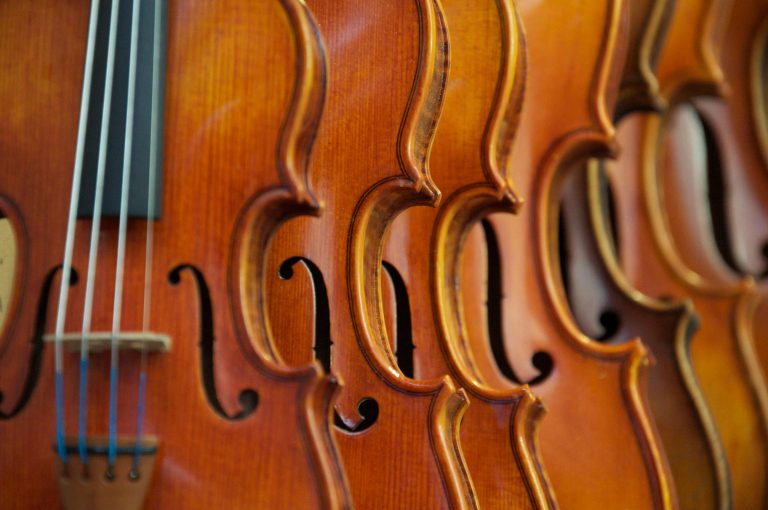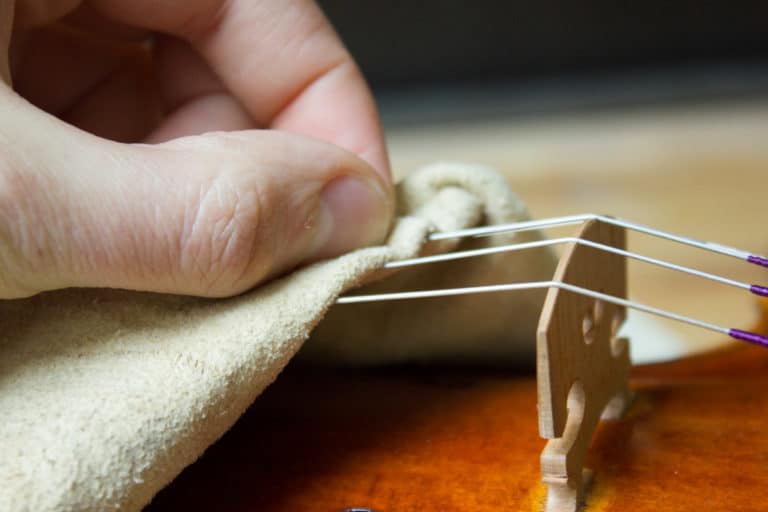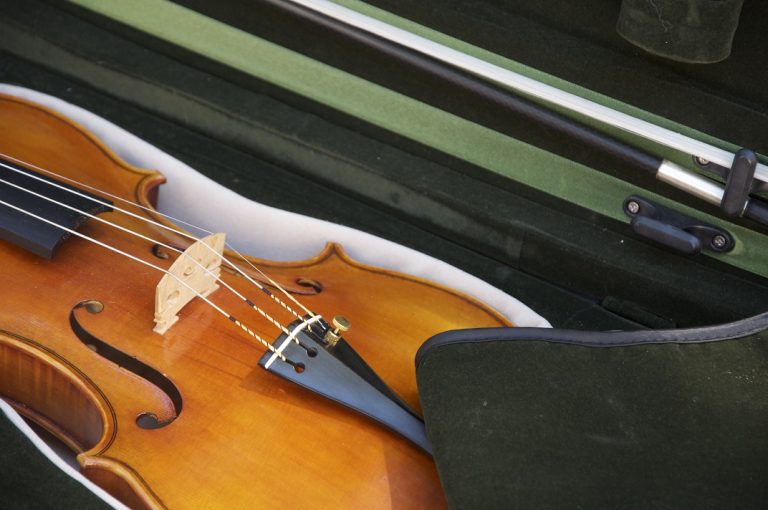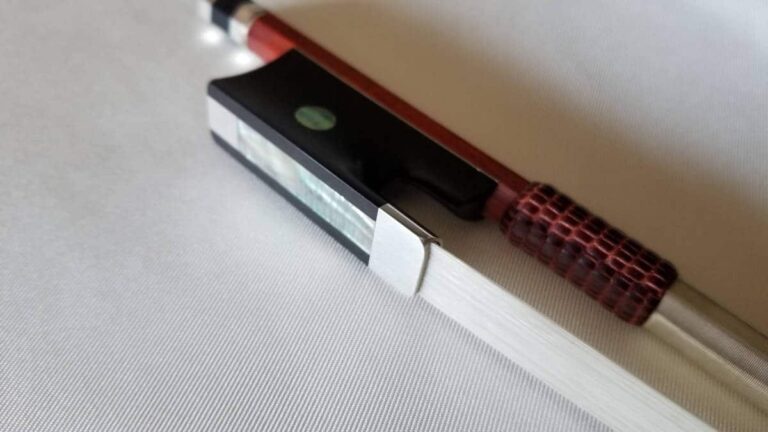Tuning your violin is a crucial step in mastering your instrument and developing your ear. It is also an essential skill for being a part of any ensemble. Here, you will discover some tips to ensure your violin, viola or cello stays perfectly in tune.
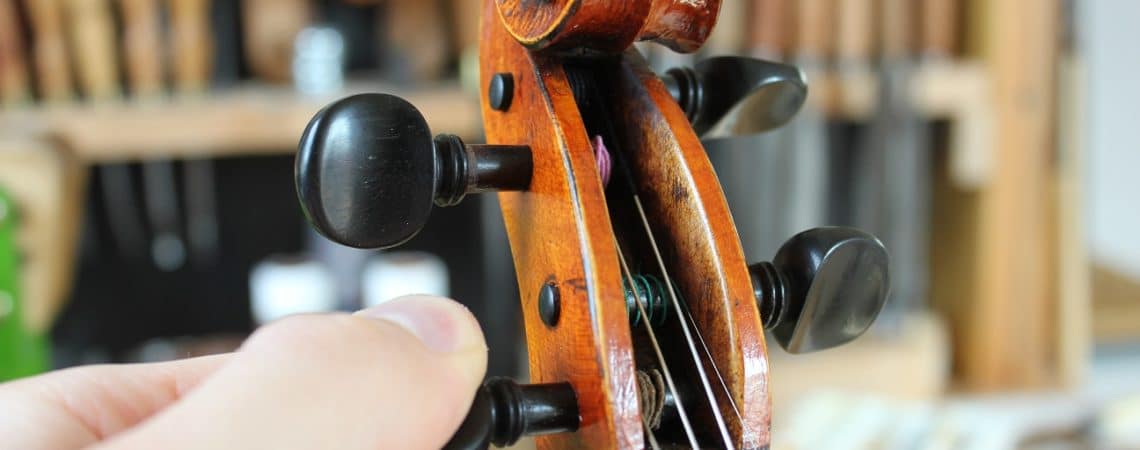
What is violin tuning exactly?
Having a tuned instrument simply means that all of the open strings have been tuned at specific intervals of sound frequency. This ensures that accurate fingerings also produce the correct notes. Tuning accuracy is critical for achieving harmony in an orchestral setting. It also reduces the possibility of creating unwanted dissonance caused by imprecise tuning.
Musicians rely on the tuning pegs to adjust the distance between the notes. Pegs and fine tuners, located at the top and bottom of the instrument, are what make tuning possible.
The strings of the violin family instruments are tuned in intervals of fifths. This means that there are five notes between each string. Take the G string for example, which is the lowest string on a violin: to reach the D string just above it, you can play an ascending G major scale (G, A, B, C, D – five notes, also known as a perfect fifth.)
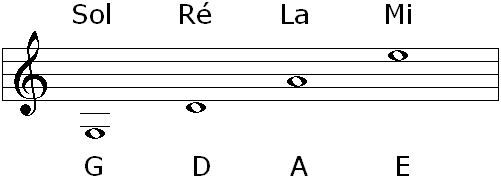
Pitch and frequencies
In the table below are the notes used to tune the instruments of the violin family. Listed are the internationally recognized names of the notes and their “standard” pitch based on A at 440 Hz.
The notes listed in the table are organized from lowest to highest. However, in practice, strings are ordered by size, with the first one being the thinnest. So keep in mind: “first string” refers to the highest string and “fourth string” refers to the lowest.
| The notes for tuning your violin, viola, or cello | ||||
|---|---|---|---|---|
| Violin | G – 196Hz | D – 294Hz | A– 440Hz | E – 660Hz |
| Viola | C – 131Hz | G – 196Hz | D – 294Hz | A – 440Hz |
| Cello | C – 65Hz | G – 98Hz | D – 147Hz | A – 220Hz |
Tuning your violin
Tuning bow instruments may seem complicated. Between the pegs that crackle when you turn them and the stiff tension of the strings, tuning can be intimidating. But don’t worry. With some practice, tuning good quality strings on a well-maintained instrument is truly satisfying.
Although tuning pegs are an outdated system, they do ensure accurate tuning and rapid restringing. This simplicity doesn’t exist with more modern mechanisms, because even though they also offer precision, they need to be manipulated far too often during the restringing process for them to be considered practical.
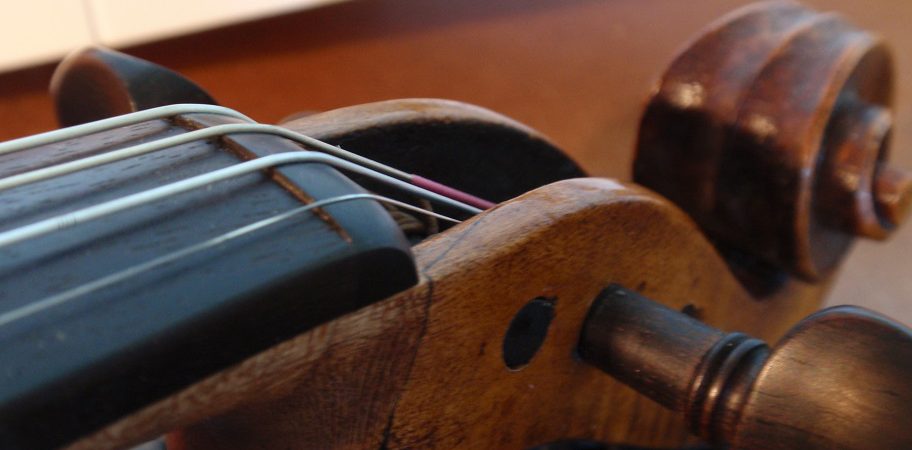
Tools for tuning your violin
Unless you have perfect pitch, the majority of people will need a reference note for tuning. Here are some common tools that can help:
Tuning forks: strike one of these objects and you will hear a pure sound – this is your reference pitch. However only an experienced ear can tune the whole instrument based on just one note.
- Pitch pipes: Pitch pipes produce a specific note when you blow into them. However, their tone can sometimes throw you off depending on the pressure of airflow, so I wouldn’t highly recommend them.
- Electronic tuners: there are various models of electric tuners available, some more affordable than others depending on their features. Most of these devices have different settings, such as tuning adapted to specific instruments, chromatic tuning or simultaneous tuning (allowing you to tune several strings at once).
- Clip-on tuners: these work the same way as the tuners above. But as their name suggests, they clip directly onto an instrument and detect its vibrations.
- Smartphones: every cell phone or tablet has (free and paid) violin tuning apps. Since our phones are usually nearby, this can really come in handy. I often use gStrings for Android. It’s free and has many useful features.
Alternative tuning options:
- Another instrument: We can always tune our instrument by using another instrument’s reference pitch. Generally, the best type of reference instrument will be the one that was most difficult to tune (such as organ, piano, etc.).
- The note that plays on your grandmother’s landline phone. It actually does play a perfectly in-tune A.
At the end of the day, even if these devices are useful, your ear will always be the key player in determining the final tuning outcome.
Tuners available in the online store
How to tune your violin, viola or cello
In theory
A string’s pitch depends on three things: length, gauge and tension.
- Vibration length: This refers to the length of the string being played. The longer the string, the lower the notes. The length of the string doesn’t change; it is set in place by the nut and the bridge. When we press on the string, we shorten its distance, and this produces higher notes.
- String gauge: This refers to the diameter of the strings. The larger a string’s diameter, the lower the notes produced will be. For instance, we can easily notice that a G string is thicker than an E string.
- String tension: Here, we refer to the mechanical tension of the strings. There are several ways to determine string tension. The greater the tension is on the string, the higher the notes will be.
In practice
Generally speaking, when referring to instrument tuning, we are talking about adjusting the tension of the strings. On violins, violas and cellos, we mainly rely on the tuning pegs. These pegs are small cones made of dense wood wedged into the pegbox. Wood friction is too large for perfectly fitted pegs to work properly. Thus, they are lubricated to help strike a balance between grip and ease of movement.
Fine tuners (or string adjusters) sometimes come on the instrument’s tailpiece. Fine tuners have a screw that allows the player to be more precise in their tuning. There are often four fine tuners on student violins, but advanced players usually prefer to only have one fine tuner (on the E string).
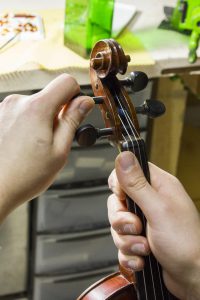
The art of violin tuning
Now let’s discuss how tuning is achieved. Assuming that the strings are already on and securely fastened around the pegs, here’s how it works:
Preparation
- Place the instrument in your lap facing upright (or between your knees if you’re tuning a cello).
- Get out your tuning device (if you have one).
Modify the pitch
- Turn the peg to loosen its grip on the pegbox.
- Turn the peg to apply pressure on the string until you achieve the desired pitch. The string must always pass over the top of the peg, not beneath it. If you’re facing your violin, this means you should be turning the pegs counter-clockwise. Depending on how well the pegs have been secured to the instrument, this should seem relatively straightforward. Things to make note of:
- Typically you will be raising the pitch when tuning. If the pitch is too sharp, you will need to loosen the string and then tighten it again to achieve the correct pitch.
- If ever the the peg refuses to turn or detaches from the pegbox, you will need to take it straight to a luthier. An alternative is to use soap or chalk to loosen or adhere the pegs, but you will need to be very careful only to use a small amount of either substance.
Block the string at the desired pitch and adjust from there
- To block the string, gently push the peg back into the pegbox. Fitting the string against the inside of the pegbox secures it and prevents the peg from slipping. Be careful however with this technique, as too much forcing can cause the pegbox to crack.
- If you have fine tuners on your tailpiece, you can use them to obtain an even more precise pitch. It is still preferable to tune your instrument with the pegs, and thus the fine-tuners should really only be used for final adjustments.
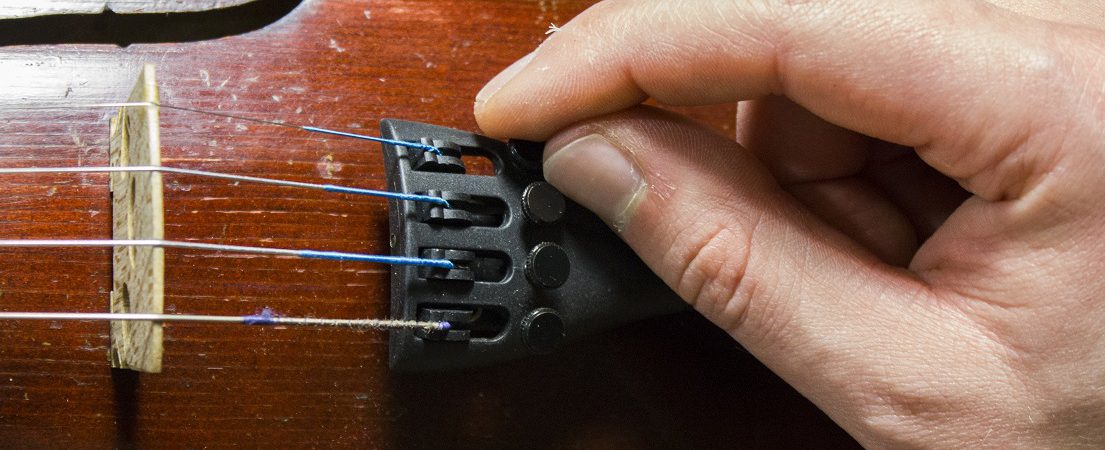
Tips for tuning your violin
Violin tuning can be challenging at first for beginner players. Here are some tips to help you overcome the most common issues on your own and to get the best outcome possible when tuning your instrument.
- Never over-tighten the strings: Over-tightening strings will shorten their lifespan and may even cause them to snap, especially if stretched three half steps above where they are supposed to be tuned.
- Change the strings one at a time: If you try restringing all four strings at once, you will notice that your violin will refuse to stay in tune and that it takes several attempts to find a stable pitch. This is because the neck, table and remainder of the instrument are weighed down by the pressure of the strings. To avoid this issue, be sure to add each string one at a time.
- New strings take time to stabilize. The tone quality of new strings is often harsh and constantly goes out of tune. Depending on the models and how often you practice, this instability can last for just a few hours or up to several days.
- Fine tuners or string adjusters are sometimes turned so far that it is no longer possible to tune. If this happens, the screw must be loosened. Then you have to tune with the peg, and finally adjust the string with a fine tuner.
- To take things a step further, you may want to use metallic pegs. These pegs deliver precision and are very low-maintenance. Pegheds, Wittner and Planetary Peg all offer a variety of metallic pegs. Switching to metallic pegs could radically improve your life as a musician.
Problems when tuning your violin – FAQ
Why does my string break when I tune it?
Extreme tension is constantly placed on the strings of a tuned violin (around 25kg‘s worth between each string). The E string can only manage about 10kg of pressure on its own. Poor quality strings that are worn out or damaged are more likely to break. Thankfully, this is not an issue with quality strings, due to rigorous quality control standards.
That being said, certain parts of the instrument that come in contact with the strings can impact their longevity. Such as:
- A protruding top nut that is not rounded, with narrow spaces between strings or poorly lubricated parts.
- Unbeveled peg holes.
- Unbeveled bridge.
- When the grip of the fine tuners or tailpieces are too sharp or abrasive.
Sharp angles that are sometimes present on certain parts of the instrument have a tendency to bend or weaken the strings. This often occurs when they aren’t set up or maintained properly. We run into these issues with most low-end instruments or with instruments that have been purchased on the Internet. To remain in tact, strings must rest on rounded, polishes surfaces.
Furthermore, do avoid over-tightening your strings when tuning your instrument. Remember that if you raise the pitch three half steps above where it is supposed to be, you raise the risk of breaking the string.
Why won’t my violin stay in tune?
Above all, it’s important to understand that a tightened string will consistently go out of tune during its lifetime. The material from which the string is made loosens up over time, something that is nearly imperceptible and has very little effect on the instrument’s manoeuvrability.
Newly fitted strings are very sensitive and consistently go out of tune in the first few hours of use.
Depending on the string type, changes in temperature or humidity may effect them. For instance, gut strings are very sensitive, whereas metallic strings are indifferent to temperature changes. These variations have an impact on how the wood of the instrument “breathes” and this then affects the tuning process.
Why won’t the strings stay in tune?
Here is a list of reasons why your instrument may be impossible to tune:
- Ill-fitted or slippery pegs.
- Bass-bar needs to be replaced.
- Table is too thin or damaged.
- Sound post needs an adjustment.
- Bridge is warped or broken.
- Tailpiece is too loose.
- One of the buttons doesn’t fit.
For any of the issues above, you will need to consult a professional luthier.
Oftentimes these problems arise from pegs that are too slippery or from wood that has retracted due to lack of humidity. Applying a small amount of chalk to the parts that come in contact with the pegs can help them adhere better. However, if the pegs are sticky and start to squeak, you will need to grease them with soap or wax. That is how traditional violin makers do these kinds of adjustments.
Do pay attention to how you turn the pegs when tuning your instrument. First, pull the peg toward you to loosen up the string. Then, turn it just until you reach the desired tension. To finish, gently push it back into place.
Why did the bridge fall off when I was tuning my violin?
When you tune your violin, the strings may pull the bridge forward, causing it slip against the instrument. This can be alarming at first. But contrary to popular belief, the bridge isn’t fastened to the violin. It is actually the strings that hold the bridge in place. To avoid problems, you will need to verify that the base of the bridge is touching the table of the violin. In most cases, you simply have to pull the bridge back up while you’re tuning your instrument. Your violin teacher or luthier can also help show you how it works, and would likely be pleased to do so.
Finally, if a bridge doesn’t fit anymore or falls off every time you tune your instrument, it means its base or core is damaged. When that happens, you will need to ask a professional luthier to carve a new bridge for your violin.
[blog_posts items=”1″ orderby=”date” ids=”9299″]
Have your violin tuned at my workshop
Don’t be ashamed if you’re still reluctant to tune your violin yourself. It’s a skill that requires time and practice before being fully mastered. If you encounter any difficulties at all, please don’t hesitate to get in touch with a professional, be it a teacher or a violin maker. After all, sometimes showing can be much more useful than telling.
Feel free to contact me or stop by my workshop. I will gladly show you how to tune your violin in person.

 Tuning forks: strike one of these objects and you will hear a pure sound – this is your reference pitch. However only an experienced ear can tune the whole instrument based on just one note.
Tuning forks: strike one of these objects and you will hear a pure sound – this is your reference pitch. However only an experienced ear can tune the whole instrument based on just one note.